Regarding the complementary structure of architectural space. Very likely, Rene Magritte is the most lucid iconic thinker of modern art. His work is monumental for the understanding of the human condition in regard to the perception of the environment, natural as well as artificial. In contrast to most other modernists, he adheres strictly to the average 'natural' perception which he decomposes to compose fictive "realities". These canvas-fictions reveal the rich relational communication inherent in materials and forms, which - in its acculturated norm - is no more readable. In the overall view Magritte shows how in our modern spatially homogenous world 'spatial fossiles' are constantly reminding us of another world, a former world in which things were perceived quite differently. The following text may outline this attempt to read Rene Magritte as a 'sous-realist' and as an iconic thinker.
Magritte the Architecturologist [1]
Regardingthe complementary structure of architectural space: By Nold Egenter
"They speak about Neon, I myself about truth"[2]
INTRODUCTION
Magritte and artificial intelligence? Are we not at the wrong place? One thing is for sure, surrealism has remained mysterious for many, particularly in its home within art. Maybe the fairly unusual milieu - quite in the sense of Magritte - allows us to put down the normal blurred spectacles of art theoreticians and to use the clear view of artificial intelligence to gain new insights.Is it not strange that computer freaks are also often fans of Magritte. Dialogue as a form of provocation. Strange relatives are met. Everyone knows that the gigantic dream of a global communication network is based on a super simple principle. "Bit", it is called, an abbreviation for binary digit, which means binary number. It is the smallest possible memory unit of any data system. It can only register the values 0 or 1. The Bit is the basis of the binary numeral systems and of binary coding. On this most elementary binary structure of 'nothing and one', further units are supported, the "Byte",further, the word, finally the whole manifold of programs. Games with pictures. Text processing. Administrative databases.
Data communication networks belong to it and recently also CAD, which more and more enters creatively into the world of design.All those who try to gain an overview of Magritte's oeuvre will soon discover to what extent architecture with concrete formations of space and even furniture, plays an eminent role.Whatever he paints in his technically fairly clumsy way, the unreal spiritual gains momentum through the real and always more or less turns around human dwelling in its objective and relative formations. In most cases the viewpoint of the observer is somehow housed or sheltered. The observer looks through windows and doors towards outside, looks from a balcony on to the ocean, etc..
Magritte composes mobile or immobile elements of the built environment. He also distorts their relations. This legitimates us to look at his pictures with the optics of architectural theory. We will see that in this way his deliberate distortions can be understood to a great extent. This is so because the complex of 'building and dwelling' contains the definitions of his formal elements and also because their characteristics are known. The cosmos of Magritte, his universe, is doubtless not the abstract space of physics, nor the space of psychology. Magritte deals with the physical space of architecture, he transmits his ideas with the language of culturally formed built space. Magritte an architecturologist? Is he really an architectural theoretician, an architectural researcher in the widest humane or anthropological sense? At the end we will see that Magritte questions not only our modern interpretation of space; there are indicators, that he offers a new world of architectural understanding with his complementary particles of built space. Like the new means of storing memory, they might become fruitful for a more humane architecture.
THE DOOR AT THE BEACH
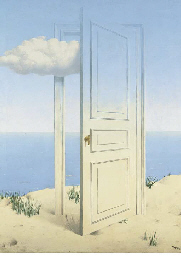
The Victory (Fig. 1)
Fig. 1: The usual door between earth and ocean, intermingled in its form with heaven and earth, what has it to say here? Taken off from its traditional milieu, it tells us what a door once was.
The picture called "the victory" (Fig.1) [3] confronts us with a door. But, unusually, it is put up near the beach, in the sand, close to the moving borderline between land and ocean. Why is this door here, isolated under the open skies, at the limits of the domains of human life? Evidently this is not a place for a door of this type, definitely not in this isolated position. The door opens or closes nothing. We can go around it: does it play monument? The answer is simple. "In my mind the 'invisible' dissolves the usual meaning of things visible in a picture. Through this our secret starts to dominate us completely. [4] Magritte tears the door off from the usual context of the house, takes it away from walls and enclosures, to demonstrate qualities which are not evident in the framework of normal use. Too much we have accustomed ourselves to its presence, to its natural function. In the unfamiliar condition at the beach, Magritte's door starts to speak in very new ways.The door is slightly open we would say. Or nearly closed? Its status is ambivalent. We can not express it clearly. The door is partly opened, partly closed. In another sense too there are difficulties.
The position, necessarily fixed in the picture, implies movement. The door is in the state of closing or opening. The 'wing' "flies" open, "falls" to closing. "Wing"? Is this not a term of the animal world? Why "wing" and what about its "swinging"? What kind of spirit is hidden in its hinges that let it move or flap? The words indicate very ancient things. But, who has formed these ideas? Are we, maybe, in the same situation like the women in Patricia Highsmith's novel "The horror of basket weaving"? Discovering her own capacity to repair a broken basket all by herself drove her nearly crazy. She had never learned it. Are there most ancient concepts living in our brains? Capacities which were developed thousands of years ago?" These are the questions she raises to herself and gets fiercely panicked. She finally burns the basket as if it were a horrible monster and thus frees herself of the problem. It was not madness, it WAS menacing. She was about to lose her identity.We do not want to go so far, but only note that the word "wing" (German: "Flügel") makes us conscious of something. Usually the frame is fixed and stands irremovably stable, it is part of a building. In contrast to this, the door is mobile, like the wing of a bird, which is fixed to its body with natural articulations.
The ambivalent function of opening and closing in the case of the door has its roots in this mobility. In contrast, the frame provides stability, keeps the door in its provided space. The door (female in German) and the frame (male in German), both are complementary like black and white, like female and male. But, not only the complementary categories of "rest" and "movement" characterise the door as unit and two conditions. The door is also articulated into fillings and frame. Is this only for constructive reasons? Very likely not! Three fields can be distinguished. A horizontal filling separates two other vertical rectangles, one in the upper, the other in the lower part of the door. The lower part, nearly quadratic, indicates closed form, static conditions. The upper part's direction is upwards. Technically all fillings are similar, they are only formally defined with different proportions. A very simple every day door? What is really shocking with this door is the way Magritte coloured it. Blue, bright, like the skies, in the upper part. Yellowish like the sand of the beach in the lower part. Thus, Magritte is definitely not an everyday painter. Or, might it have been the interesting idea of good designer imagination? Evidently Magritte does not want this.There is this mysterious cloud, which pushes itself into the space left open by the door. The cloud speaks. Blue is not just blue like the skies. Blue IS the skies. The intermingling of far and near implies the upper part of the door is part of the skies, the lower part is part of the earth. This is not meant simply in the common symbolic sense, as a 'make-look-like' image of heaven and earth. The image tells us much more. The door IS at the same time heaven and earth. It is interpreted as a dual or polar unit composed of two antithetic domains. [5]
If this situation is - as mentioned above -taken in the philosophical sense as an expression of non-analytical thought which organises the world metaphorically into complementary analogies, then a new access path is formed. By its absurd position at the beach, standing in sand, the door is decisively de-functionalised and put into a quite different context. The door now stands in the framework of a more ancient system which organises phenomena genetically (once and now) as unity of contradictions (coincidentia oppositorum) to harmonise them. The door is identical with heaven and earth in regard to the harmonious relation of its contrasting parts.The discovery of this vertically complementary organisation of the door becomes retro active on the whole structural framework. Evidently Magritte has not put his door just by chance on the borderline between land and ocean. First, a further concept is shown. Land, the earth, man the upright walker's medium has its limits. His living domain ends in front of a surface on which there is no walking.
This medium can not support his feet. The waters are adapted to it for other types of existences. Thus the door in Magritte's painting does not separate two identical spaces, as this is usually the case with a door separating for instance two office spaces. Magritte's door stands on the borderline between two absolutely different domains.Let us carry the door back into a house, but using this image. Another meaning can be seen differently. The door of a house facing the street for instance is not an ambivalent hole in some wall, it relates and separates ocean and sand, heaven and earth. Earth in the sense of being reliable, being accessible to man. Heaven in the sense of correlation of an unknown illimited. Is our apartment not in most cases the unique place on earth, where we know even the smallest thing in all detail? Is it not reigned by a principle of organisation which we control - at least in the case of furniture - to the absolute and smallest detail? On the other hand, is there not some sort of similarity between the street and the ocean, even the skies?
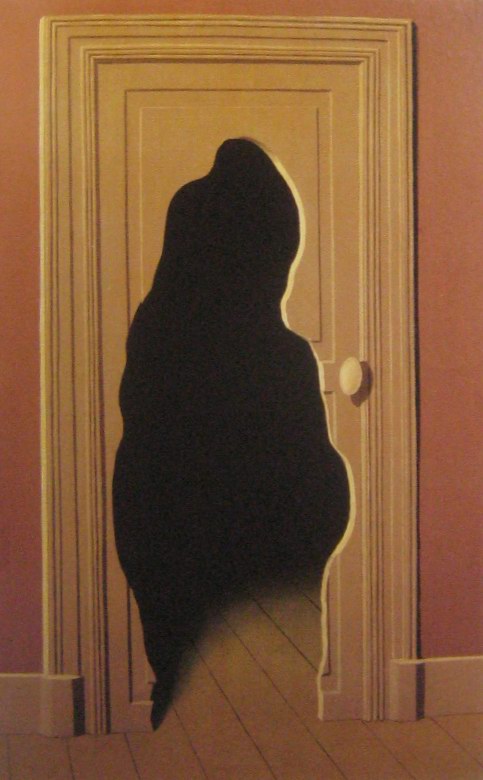
Fig. 2: The hole frightens us. Violence. Non-culture. Thus, is the door more than a hole in the wall?
In another picture too, Magritte tells us that the door is more than a hole in a wall. The formless breakthrough which opens into the dark of the next room is frightening us (Fig. 2) [6]. The amorphous dark hole speaks of force, of non-culture, of anti culture. We feel the sacrilege, the stolen treasure. The door has lost its protective capacity. With the hole it also loses its ambivalence. The broken door can not just be closed anymore by a swinging movement of the hand.
Evidently, Magritte does not superficially teach us diffuse 'surreal' realities. He is not just a casual innovator of dreams or illusionary alterations of reality. With deep reflections and intensity he reconstructs very precisely lost structures of the past, conditions which are no more conscious to us. Magritte is not really a 'surrealist'. Dealing with what is below the surface, he rather would have to be considered a 'sous-realist'. Like an archaeologist he digs out what is culturally submerged, the history of the door from below. He searches for conditions which are subconsciously experienced, maybe, but usually answered merely by surprise, for instance in the case of the door: why is that so? But theycan no more be consciously formulated. In short, he portrays a substrate of spatial reality conditioned by the history of culture which is intensively related to the concrete disposition of building and dwelling.
MAGRITTE AS EXPERIMENTOR USING ARCHITECTURAL THEORY
The whole oeuvre of Magritte is organised in this way. He experiments with one or many houses, asks spatial, temporal and causal questions in and around buildings, produces tests with parts of houses, with the 'in front' and 'behind' of walls, with furniture, with monuments.
Houses
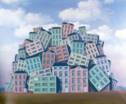
Fig. 3: Houses heaped up like cars at a car dump. Evidently this is not the way houses act in this situation. Houses collapse into ruins. In spite of this, this is the way we conceive dwellings. The picture indicates we have misconceived houses in our heads.
"The breast" (Fig. 3) [7] shows numerous three to four-floored houses heaped up like in the case of a 'car-dump'. Evidently Magritte questions the box-concept of modern architecture. The picture looks very strange, because, usually, houses cannot be 'heaped up' like this. They are not stable units that can be vertically piled up under any spatial conditions like boxes, cars, or pieces of wood. Houses of this type are composed of different elements.They fall apart correspondingly. Everybody knows the heaps of rubble that are found after a house has been torn down, after an earthquake, after bombardments, etc.. Walls, windows, doors, roofs, they are falling according to their own structural laws. By painting an intact 'dump' of houses, Magritte ironically questions our ideas about the house as a machine-like unit. It is not a tool for dwelling, a planned functional whole. It follows other laws, those of a gradually evolved tectonic cultural landscape intimately related to man. Doors, windows, rooms etc. all have their own lives, their own structure, their own history. Note that in Magritte's 'house-dump' no human being is indicated!
Magritte
Fig. 4: Architectural speculation has moved away from the ground getting caught in the heights of an absurd tower. Very similarly Magritte criticises this merely technical way of thinking also in his watercolour painting "Spiritual look" (Fig. 4) [8]. The architectural "speculation" has moved away from the grounds of humans towards the heavens into an absurd tower.
Inside space
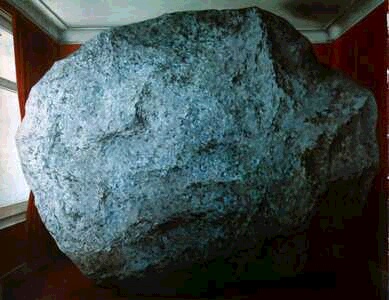
The Anniversary (L’Anniversaire) 1959
Fig. 5 Death, the static and non changeable: the heavy rock blocking the whole room frightens the observers. Numerous are the interior rooms used by Magritte in his experiments. They are jammed with gigantic roses [9], with green room size apples [10], or simply with a huge rock (Fig. 5) [11]. Its teachings: space is not empty, abstract, like that which is preached in physics. Space needs man as a dweller.
And with this, beauty, poetry, meaningful articulation comes in. This type of space also carries an immanent tension towards nature. We think of the endless 'decorations', the garlands with branches, leaves, flowers and fruits represented in ceramics, plastered or hewn in stone, thus made durable, embellishing the history of architecture. With this over emphasised filling of living rooms, Magritte also critically questions the whole history of the ornament.
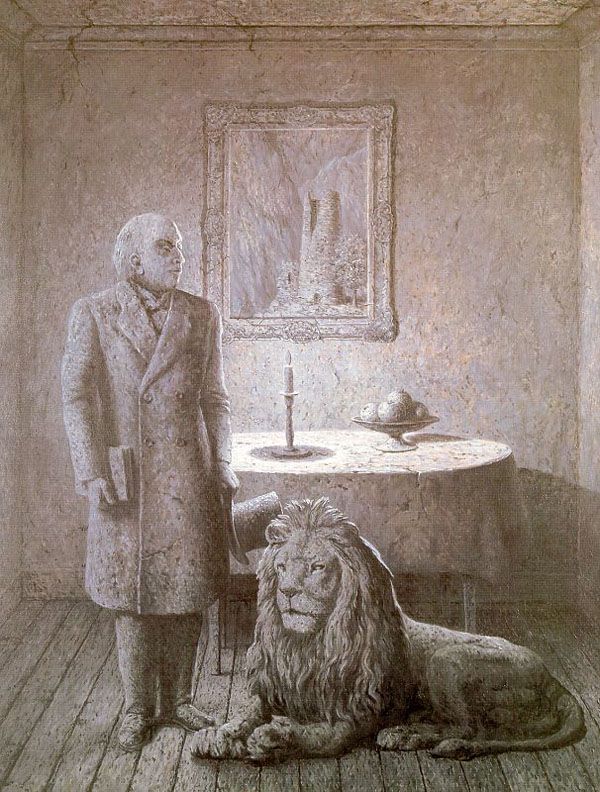
Fig. 6: The petrified "snapshot". Materials used in building do not simply have practical functions. Its textures speak with the inhabitant.
Similarly this is the case in his "Souvenir of a travel III" (Fig. 6) [12]. Alluding to an ancient photo as a souvenir of a personal life phase, the inside of an apartment is painted with a stone texture. A ruin in the background forms the centre of the picture and indicates the topic. Tree, mountain slopes and picture frame are all part of the lithic texture. From there light falls into the room, it illuminates the man, the lion and the table with fruits. Everything has become a ruin. Power and life are frozen to immobility, durability. Death and tombs are evoked. The table too, the "still" of a "still life" painting dominates the scene. In spite of this there is a mysterious life, particularly in the realism of the forms. The picture owes its mysterious tension to this. The candle too emanates light, in spite of the fact that even the flame is represented as stone. In short, the "snapshot" of an interior shows with all clarity that space is not empty. It is evident that materials act upon our mind in a comparative framework of analogies.
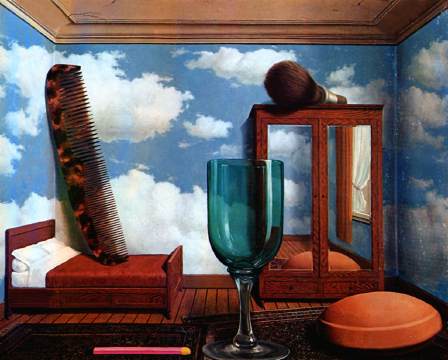
Personal Values 1952
Fig. 7: The eternal dream: the heavenly room. But we need codes securing us against the fears of falling down.
In contrast to this let us take a look at the "Heavenly room" (Fig. 7) [13]. A room without walls? Lofty clouds are seen all around. Dwelling in the skies, that is what they all want.Transcendence here on earth. Terraced housings with the view of God over the commoners. Skyscrapers, in fact an incrusted striving for the heavens. An enlightened type of religion? Unfortunately this degenerated metaphysics gets into conflict with daily reality. In Magritte's 'heavenly room' the plastered ceiling is there, provides shelter, symbolises place, steals the dimension of being lost out of the dream. There is a quite everyday bed seen from the front. At its back, the wooden strip at the bottom keeps it from crashing down. Walls too suggest support. The usual corners are there. Thus, this space is not totally illimited as this is 'normal' for the heavens. Any attacks of dizziness can also be avoided by strictly interpreting the walls as covered safely with wallpapers showing clouds. The closet too and the comb leaning to the wall, the everyday norms, may calm us down. Similarly the painted window and curtain. But only for a moment. Doubts are always present. The window is only a reflex. Similarly the size and unusual position of the other elements suggest insecurity. Is the object in the foreground an inviting cushion,related to the glass, to the razor soap, the close friend of the razor brush on top of the wardrobe. The ambivalent situations and the transformed conditions favour insecurity: are we flying in a magically constructed room in the air without ground high up in the clouds? In short, the picture speaks of the conflict between the 'skyscraper dreams' of architecture and everyday human orderliness providing security on stable grounds. Most importantly the same room suggests security but at the same time frightens us.
House parts
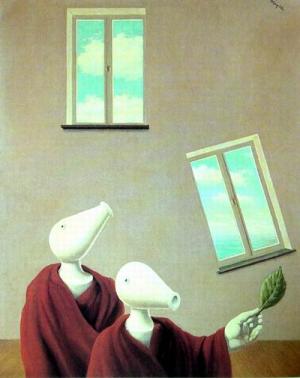
Fig. 8: In view of the eternal horizon of the ocean outside we become aware of the arbitrariness of the oblique window but also of the eternal law of tectonics.
In his "Les rencontres naturelles" (Fig. 8) [14] Magritte puts a window obliquely into the wall. In the foreground there are two "technocrats" with their pear shaped techno-heads. Wearing red tunics they are on a kind of viewing tour through the house. Evidently very important people. The one in front holds a green leaf in his crude hand, meaning life, movement, change, development, progress. But the leaf is directed towards a strange innovation! The whole upper part of the picture is characterised by two windows. The upper section of the window on the left looks quite normal, shows clouds. The lower one on the right similarly normal in regard to outside, clouded horizon of the sea. But the window is completely arbitrarily set into an oblique position. Conflict here too. The gigantic spirit level outside seriously questions the oblique window. Natural order, tectonic order - the 'normal' window and the arbitrary 'freedom' of man.
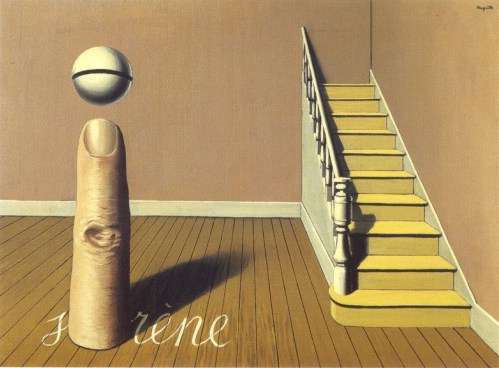
Forbidden Literature or The use of the Word (Irene)- La Lecture Defanse ou L'Usage de la Parole, 1936
Fig. 9: Stair blinded by wall on upper end, thus absurd.Magritte's stair says: I am more than the sum of my steps.
Marvellous how Magritte manages to make stairs look absurd (Fig. 9). On its upper end it is blocked by a closed wall. [15] No aperture that leads on, no podest, which relates the above to the below. Those who go up here must definitely return. The process in both parts, going up and going down, is devalued, develops nonsense. The paradoxical communication character of the stairs becomes clear. They are not only connecting different parts of space or rooms, they imply an environmental change from below to up and reverse with all consequences of sight and feeling of ones body. The finger set up like a monument hints to the principle that is always immanently present in Magritte's paintings: the twofold and freely floating sphere, his code for complementarity.
The nonsense of homogeneous space
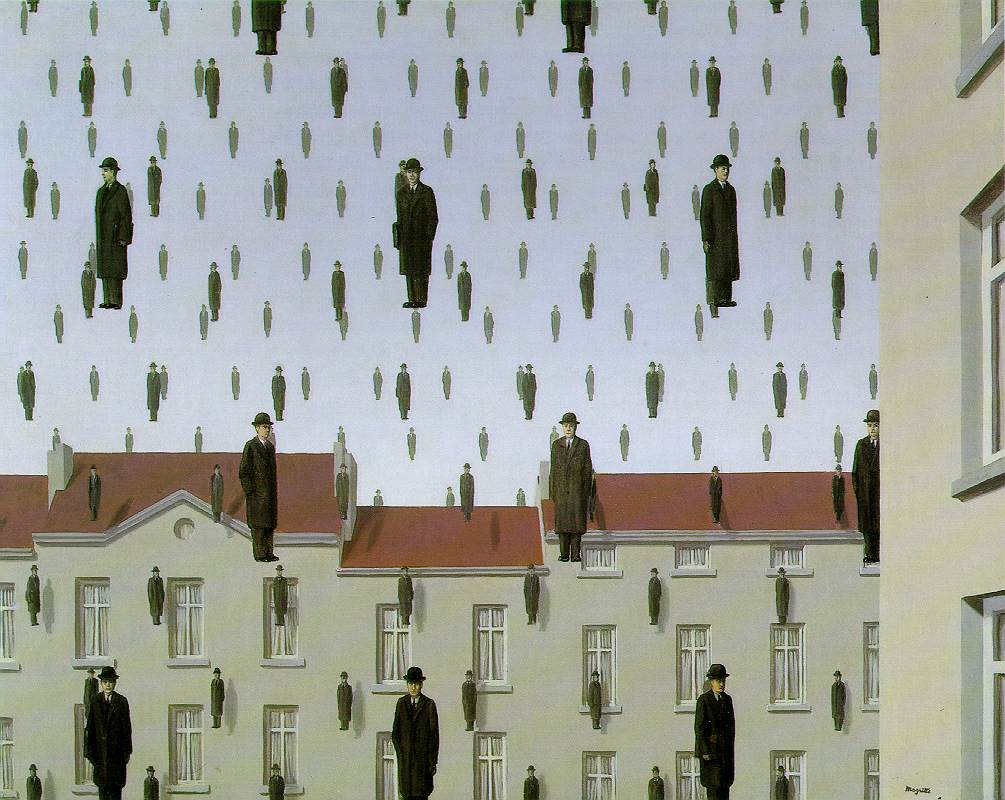
Fig. 10: Magritte vehemently attacks the homogenous space concept of modern architecture: the human being is not a particle moving around in open space!
Finally a further picture: the Golconde (Fig. 10) [16]. Magritte painted it to reduce to absurdity the modern mathematical idea of homogeneous space. As if somebody had released a great quantity of balloons, many of Magritte's typical melon-men are "standing" vertically dispersed in space. Three different modes define distribution and size, giving the illusion of spatial depth.The heavy facades immediately behind the figures in the foreground emphasise the contrast to the fictive "standing" of the black dummies. Evidently they behave as if their standing around like on an Italian piazza - everyone at his place - were the most normal thing in the world. Remarkably, Magritte provides shade for the figures where they are close to the facades. The contrast between illusion and reality is emphasised. Also important is the very homogeneous way Magritte painted the sky. Space in its absolute sense is implied.
Maybe, thematically, this is one of the most important of Magritte's paintings. It drastically shows the error of modern architecture and urbanism. Man can not be assumed like a particle in physics at any arbitrary position in space. He requires clear conditions. In answering these, man follows a specifically structured space concept, formed by the tradition of his constructions. He builds his walls, fences, paths. He opens gates, doors,windows from inside towards the outside, from outside towards the inside. He organises light and dark, openness and seclusion, as we see it in many cultures.These organisational principles are not "created" by ourselves, they have "ancestors", thousands of years old. Most importantly, these principles have preserved a spirit which speaks to us. These teachings should be know by those who build for man. Magritte researched exactly these teachings. He thus manages to show that architectural space is not empty, nor homogeneous. Magritte shows that space creates conditions related to man, shows that buildings, parts of buildings and furniture are projecting a network of relations into our lives. They intensively talk to us, even when there are no words heard.
CONCLUSIONS
The language of architecture? Maybe Magritte can now be understood as an "architecturologist", as an intense researcher into the secrets of architecture. Very likely it is not by chance that, in opposition to contemporary movements suggesting the dissolution of space, he tenaciously remained loyal to perspective as a means to represent space. He needed the tectonically constructed view and its fixed eye point to make statements about the structure of built space. His simple 'trompe-l'oeuil' technique too adapts to this. Only as a realistic spatial representation can it make its statements.In this way Magritte is also an architect.
However, not an architect who is content with seeing his sketches done on the drawing board blown up by developers into public human space. He mixes his ideas with liquid colours, paints them on his walls consisting of canvas. In this way he creates his own freedom: he builds what he wants. Early he must have become aware that what man really needs is not more bodily commodities, but that modern architecture had lost the spiritual. Magritte shows us what is lacking. Is Magritte, unseen for most, in fact, the greatest architect of our times? Maybe he is also a visionary far ahead of time.Initially we have compared Magritte with the recent data processing world.
With a tremendously simple, but incredibly variable binary principle, electronics are conquering the world, providing very unexpected new potentials. Magritte's experimental world of architectural research can be seen in very similar ways. Based on an elementary, but highly complex multicategorial principle of complementary units, he develops a new language in painting, which we tried to read. Magritte's oeuvre shows us the world of architecture in new ways. But what distinguishes him from electronics is his decisive focus on man. He makes us discover an immensely deep spectrum of qualitative, quantitative, temporal and spatial categories, through which man can continuously communicate with the cultural spaces of architecture.
Notes
1 The term is taken from the lecture list of a French architectural school: Activities d'enseignements 1988/89; Ecole d'architecture de Paris-La Villette: P. Boudon: Architecturologie -Theories et doctrines architecturales; : 148/49. See also the series of the same school about 'thinking space' (Penser l'espace).
2 This remark of Magritte was reported by Maurice Rapin (Aporisms 1970 : 20) acc. to Torczyner, London 1979 : 48.
3 1939, Passeron, Cologne 1985 : 23. In regard to all cited pictures the following is valid: The titles do not describe the content of the pictures. This is not only corresponding to Magritte's skeptical attitude in regard to language. In an interview Georgette Magritte explains how casually the titles were found, talking playfully with friends, purposely arbitrary. "The title is not an explanation of the picture." (Passeron 1985 : 13)
4 Letter of Magritte to Maurice Rapin. 31. March 1958, acc. to Torczyner 1979 : 46
5 This should be taken in the sense of anarchitecturo-theoretical interpretation, the intention is not to classifythis structure into the history of religion (see e.g. Mircea Eliade: the Holy and the Profane). Hinting to Chinese thought, it could be argued then that heaven and earth and the polar door have a much higher proximity in the polar cognitive system than they have in our analytical system of judgments.
6 La reponse imprevue 1933, Mus. Royaux Brussles.Retrospective R. Magritte, Tokyo 1971, S. Torczyner 1979 : 34
7 1960, Passeron 1985 : 72/73
8 53x35, non dated, Passeron 1985, : 71
9 Le tombeau des lutteurs 1960; Torczyner 1979, : 76
10 La chambre d'ecoute, oil on canvas, 1953;Torczyner : 77
11 L'anniversaire, 1959; oil on canvas, Toronto,Canada. Torczyner : 78
12 1955. Hermitage, Lausanne 1987 : 16 (110 bis)13 Les valeurs personnelles, 1952, Private collection, New York; Torczyner 1979, S. 16/17.
l4 1945 Coll. Scutenaire, Brussels; Torczyner1979, : 98.
l5 L'usage de Ia Parole. 1932, Coll. Scutenaire,Brussels; Torczyner 1979, S. 54 (Nr. 60).
l6 Golconde,